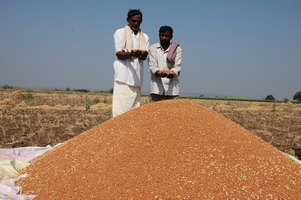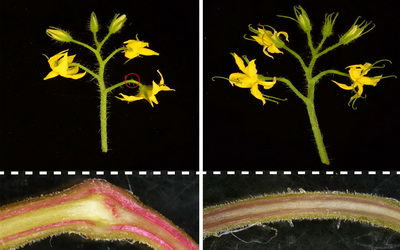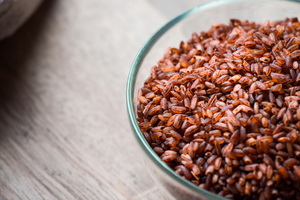CROP BIOTECH UPDATE
---------------------------------------------------------------------------
A weekly summary of world developments in agri-biotech for developing countries, produced by the Global Knowledge Center on Crop Biotechnology, International Service for the Acquisition of Agri-biotech Applications SEAsiaCenter (ISAAA)
---------------------------------------------------------------------------
May 8, 2019
In This Week’s Issue:
News
Global
Global Team Sequences 429 Chickpea Lines from 45 Countries to Develop High-Yielding, Climate Resilient Crop
Africa
Genome Analysis of African Yam Backs Niger River as Cradle of African Agriculture
Americas
Scientists Release Most Accurate Peanut Genome Sequence to Date
Researchers Identify Cause of Seed Abortion and Role of RNA Pol IV Enzyme in Seed Development
Asia and the Pacific
New Gene Metrics Increase Precision of Plant Breeding Technology
Climate Extremes Explain 18%-43% of Global Crop Yield Variations
Europe
Genomes of 480 Wheat Varieties Reveal Evolution, Human Sociocultural History
Study Reveals Climate Change Boosts Banana Disease
Healthful Oils from GM Plant as Effective as Fish Oil
Research
Experts Characterize Cadmium-responsive MiRNAs and their Target Genes in Maize
New Breeding Technologies
Study Shows How Nature Makes Solution to Hidden Mutations
CRISPR-Cas9 Used to Recover Red Pigmentation in Elite Rice Varieties
Announcements
ASEAN-U.S. Science Prize for Women
Document Reminders
Interactive Map Shows Crop Field Trial Sites in Australia
----
NEWS
----
Global
GLOBAL TEAM SEQUENCES 429 CHICKPEA LINES FROM 45 COUNTRIES TO DEVELOP HIGH-YIELDING, CLIMATE RESILIENT CROP
 A study conducted by scientists from 21 research institutions all over the world has successfully completed the sequencing of 429 chickpea lines from 45 countries and identified genes that could help develop drought and heat tolerant chickpeas. Led by the International Crops Research Institute for the Semi-Arid Tropics (ICRISAT) and BGI-Shenzen, the research team came from 39 leading research institutes.
A study conducted by scientists from 21 research institutions all over the world has successfully completed the sequencing of 429 chickpea lines from 45 countries and identified genes that could help develop drought and heat tolerant chickpeas. Led by the International Crops Research Institute for the Semi-Arid Tropics (ICRISAT) and BGI-Shenzen, the research team came from 39 leading research institutes.
Lead researcher Dr. Rajeev Varshney said the team identified genes such as REN1, β-1, 3-glucanase and REF6 which can help crops tolerate temperatures up to 38 degrees Celsius and produce higher yields. Genome-wide association studies identified 262 markers and several candidate genes for 13 traits.
The study also tracked the origins of chickpeas, and confirms that the crop came to India from the Fertile Crescent/Mediterranean via Afghanistan and may have been introduced back to the primary centers of origin after 200 years. "Our study indicates Ethiopia as a secondary center of diversity and also maps a migration route from the Mediterranean/Fertile Crescent to Central Asia, and in parallel from Central Asia to East Africa (Ethiopia) and South Asia (India)," said Dr. Varshney.
Results published in Nature Genetics state that more than 90% of chickpea is planted in India, where the highest genetic diversity was observed.
For more details, read the news releases from ICRISAT and the University of Western Australia.
Africa
GENOME ANALYSIS OF AFRICAN YAM BACKS NIGER RIVER AS CRADLE OF AFRICAN AGRICULTURE
A team of scientists published the results of their work that proved that the African Yam's expansion of cultivation started in the Niger River basin. Moreover, the results highlighted that the African Yam actually descended from a forest species. This is contrary to an assumption that sub-Saharan African plants mostly arose in tropical savannahs.
Yam is a key crop in Africa, second only to cassava in terms of production. Dioscorea rotundata is the most cultivated yam species, and it has two close wild relatives: one savannah species (D. abyssinica) and one forest species (D. praehensilis). The scientists speculated that the domesticated yam was likely to come from one of the two wild relatives, or from hybridization between the two. After whole-genome re-sequencing of 167 wild and cultivated species of yams, along with sophisticated statistical modeling, results showed that the cultivated yam was domesticated from the forest yam species.
The findings led to the support of the hypothesis that the vicinity of the Niger River basin played a major role in the domestication of African crops and is comparable to the Fertile Crescent in the Near East. The study also showed that the origin crop domestication covers a more restricted site in the western Sahel near the Niger River basin, challenging the idea that the origin of crop domestication covers a bigger area between Senegal and Somalia.
The history of crop domestication in sub-Saharan Africa is much less documented and archaeologically fragmented. By piecing together the origins of domestication of crops, yam among them, scientists have a better view of where the crops being used today came from. Understanding a crop's origins and the genetic exchange among its relatives may lead to the future studies of hybridization to improve a crop even further.
Read the full article published by Science to know more.
Americas
SCIENTISTS RELEASE MOST ACCURATE PEANUT GENOME SEQUENCE TO DATE
Better resistance to pests and improved tolerance to drought are just some of the possible benefits of the USDA Agricultural Research Service (ARS) initiative that successfully produced the clearest illustration yet of the complex genomic history of the cultivated peanut (Arachis hypogaea).
The USDA scientists and collaborators conducted the project to elucidate the molecular and cellular mechanisms that define the growth and development of a peanut plant, including the expression of desirable characteristics such as high seed yield, enhanced oil quality, and resistance to diseases.
In 2006, the researchers reported the successful sequencing of two wild peanut ancestors separately. In their recent study, they used advanced DNA sequencing equipment and sequences the two merged genomes in a single commercially grown peanut to get the missing information they missed in the previous study. The researchers also tried to recreate this genomic merger by crossing two ancient peanut species and analyzed the results in 7 generations of offsprings. The findings showed a fascinating trend of DNA switching and deletions that took place in the offsprings, which might be the cause of diversity in seed size, shape, color, and other characteristics of the current cultivated peanuts.
Read more results from USDA ARS.
RESEARCHERS IDENTIFY CAUSE OF SEED ABORTION AND ROLE OF RNA POL IV ENZYME IN SEED DEVELOPMENT
In flowering plants, the embryo is surrounded by the endosperm, which facilitates transfer of nutrient between embryo and the mother. The endosperm is distinct as it contains only one copy of the father's genome and two copies of the mother's. This maternal to paternal ratio is remarkable because of its importance to seed viability and development. Seeds with extra genomes that alter this critical ratio undergo a process known as interploidy seed abortion due to defective endosperm development.
The enzyme RNA Pol IV is specific to plant genomes that generate small RNA molecules silencing gene expression from transposons and repetitive DNA, playing a major role in defending the genome against viruses and transposable elements. A study published in Plant Cell shows that RNA Pol IV plays a key role in interploidy seed abortion.
The study shows that RNA Pol IV targets genes in the father through the "canonical" RNA-directed DNA methylation pathway. This results in interploidy seed abortion. The researchers then compared gene transcription in the endosperm of aborted interploidy seeds with seeds that were viable due to the loss of paternal RNA Pol IV. They found that transposons and thousands of genes, even imprinted ones, were misregulated in both living and dying seeds and learned that misregulation of a relatively small number of genes sets living seeds apart from aborting ones.
Read more details in the paper's abstract available in Plant Cell.
Asia and the Pacific
NEW GENE METRICS INCREASE PRECISION OF PLANT BREEDING TECHNOLOGY
Scientists from the International Rice Research Institute (IRRI) have developed new gene metrics to determine the accuracy of molecular markers used in marker-assisted selection (MAS).Breeders have long been using MAS to determine distinct and desirable traits in plants such as disease resistance, grain quality, and flood tolerance. Though this method proved to be effective in accelerating the breeding process, they found that it is still susceptible to inaccuracies.
With this in mind, the team at IRRI developed five standards to thoroughly assess the performance of genetic markers used in MAS. The researchers discovered that markers that fared well on the metrics were significantly reliable, thus increasing the efficiency of the MAS technique. This could boost the confidence of breeders to use the markers in their breeding programs. The metrics can also be used across different marker types and platforms, which will allow scientists to evaluate markers not only for rice but also for other crops.
For more details, read the news article in Rice Today.
CLIMATE EXTREMES EXPLAIN 18%-43% OF GLOBAL CROP YIELD VARIATIONS
A group of researchers from Australia, Germany, Switzerland, and the USA has quantified the effect of climate extremes such as droughts or heatwaves on the yield variability of staple crops around the world.
Overall, year-to-year changes in climate factors during the growing season of maize, rice, soy and spring wheat accounted for 20%-49% of yield fluctuations. Climate extremes, such as hot and cold temperature extremes, drought and heavy precipitation, by themselves accounted for 18%-43% of these interannual variations in crop yield.
The researchers used a machine-learning algorithm, Random Forests, to tease out which climate factors played the greatest role in influencing crop yields. They found that the most important climate factors for yield anomalies were related to temperature, not precipitation. The researchers also identified global hotspots areas that produce a large proportion of the world's crop production, yet are most susceptible to climate variability and extremes. The following hotspots were identified: North America for soy and spring wheat production, Europe for spring wheat, and Asia for rice and maize production.
For more details, read the article in ARC Centre of Excellence for Climate Extremes.
Europe
GENOMES OF 480 WHEAT VARIETIES REVEAL EVOLUTION, HUMAN SOCIOCULTURAL HISTORY
An international team of scientists involved in the large-scale WHEALBI study has analyzed the genomes of 480 wheat varieties, including wild grasses, ancient grains, and modern high-performance types. The research team learned about the evolution and cultivation of today's bread wheat and also found the links in wheat development to geographic and geopolitical events in human history.
The research team in Plant Genome and Systems Biology group (PGSB) at the Helmholtz Zentrum Mόnchen identified three gene pools in the bread-wheat varieties used today that are closely linked to historical events: one from high-yielding varieties domesticated in the near east that spread as part of the green revolution and two separate gene pools from Western and Central Europe. They diverged between 1966 and 1985 as a result of geopolitical and socio-economic separation during the Cold War. With the fall of the Iron Curtain in 1989, their genomes reveal that the wheat lines gradually admixed again.
The researchers identified previously unknown genes that influence yield, flowering time, height, and stability of wheat plants. It was also revealed that the genome of today's wheat shows the emergence and expansion of the European Union. Wheat lines that used to be cultivated mainly in Central Europe are now used throughout Europe.
For more details, read the news release from Helmholtz Zentrum Mόnchen.
STUDY REVEALS CLIMATE CHANGE BOOSTS BANANA DISEASE
A new study at the University of Exeter reveals that climate change has raised the risk of Black Sigatoka, a fungal disease that ravages banana crops.
The study, which combined experimental data on Black Sigatoka infections over the past 60 years says changes to moisture and temperature conditions have increased the risk of Black Sigatoka by more than 44% in Latin America and the Caribbean since the 1960s.
"Black Sigatoka is caused by a fungus (Pseudocercospora fijiensis) whose life cycle is strongly determined by weather and microclimate," said Dr. Daniel Bebber, of the University of Exeter. He added that climate change has made temperatures better for spore germination and growth, and made crop canopies wetter, raising the risk of Black Sigatoka infection in many banana-growing areas of Latin America.
For more details, read the news article at the University of Exeter website.
HEALTHFUL OILS FROM GM PLANT AS EFFECTIVE AS FISH OIL
 Healthful oils derived from plants are processed by the human body in exactly the same manner as when fish oils are eaten, according to a research led by the University of Southampton's Faculty of Medicine.
Healthful oils derived from plants are processed by the human body in exactly the same manner as when fish oils are eaten, according to a research led by the University of Southampton's Faculty of Medicine.
Omega-3 fats are mainly present in fish oil and are vital for health and development. Because of Omega-3 source limitation, Rothamsted Research scientists developed a seed oil plant (Camelina sativa) using genetic engineering to produce an enhanced vegetable oil with similar amount of eicosapentaenoic acid (EPA) and docosahexaenoic acid (DHA) as fish oil.
University of Southampton, in collaboration with Rothamsted Research, tested if the GM camelina oil is as good as fish oil in providing fatty acids in human diet. The findings, published in British Journal of Nutrition, show that when young and middle aged men and women consumed the same amount of EPA plus DHA in a single standard meal, either as fish oil or as the oil from the GM camelina, there was no difference in the uptake of these fatty acids from the meal or the body processing these fats.
Read more details from the University of Southampton and Rothamsted Research.
Research
EXPERTS CHARACTERIZE CADMIUM-RESPONSIVE MIRNAS AND THEIR TARGET GENES IN MAIZE
Studies have shown that microRNAs (miRNAs) have significant functions in plant's response to stress brought by exposure to heavy metals. Cadmium, a heavy metal, is one of the most deleterious pollutants in the environment. Maize is a good candidate for investigating phytoremediation of Cadmium-contaminated soil because of its large biomass production. Furthermore, there is limited information about miRNAs as a response to Cadmium stress in maize. Thus, experts from Yangtze Normal University conducted a study to understand the function of miRNAs in response to Cadmium stress. The results are published in BMC Molecular Biology.
The research team collected roots of seedlings of inbred maize lines B73 and Mo17 that were subjected to Cadmium over varied exposure times. Cadmium stress was confirmed through levels of enzymatic activities. The expression of six candidate miRNAs and their targets were validated using quantitative real-time PCR technology; while the expression of Zma-miR171b was evaluated using in situ hybridization.
Results showed that miRNAs and their respective target genes were differentially expressed in maize seedling roots exposed to Cadmium stress. The results also provided insights into the molecular mechanism of miRNAs in response to Cadmium stress and confirmed that miRNAs in plants play important roles in responding to heavy metal stress.
Read more findings in BMC Molecular Biology.
New Breeding Technologies
STUDY SHOWS HOW NATURE MAKES SOLUTION TO HIDDEN MUTATIONS
 Genetics professor Zachary Lippman, together with team, shared the result of their study on cryptic mutation and some vital lessons for gene editing in crops. Their study is published in Nature Plants.
Genetics professor Zachary Lippman, together with team, shared the result of their study on cryptic mutation and some vital lessons for gene editing in crops. Their study is published in Nature Plants.
The research is founded in the story of Campbell Soup Company and a field of tomatoes back in the mid-20th century. In the field of tomatoes, one plant had a surprising characteristic-the fruits separated from the vine right where the green cap and step touch the rest of the fruit. This jointless mutant plant was ideal for large-scale production because the other varieties would break away at a joint-like nub in the fruit stem, leaving pointed green caps that puncture other tomatoes in transit. The breeders called the gene mutation as jointless-2 (j2) and tried to introduce it into many varieties. However, doing so led to jointless tomato plants with excessive branching.
In 2017, Lippman and colleagues revealed that an ancient gene mutation interferes with j2 leading to a cryptic mutation. Now with the advent of gene editing techniques such as CRISPR, scientists can make fine adjustments in the mutations to prevent negative interactions that hinder agricultural production. Lippman also found that some breeders were able to neutralize negative interactions by duplicating the ancient mutation that interacts with j2. In other words, doubling the ancient mutation gives the same result as having no mutation at all.
"This [duplication event] was naturally occurring, so basically, nature provided the solution to its own problem," Lippman stressed.
Read more from Cold Spring Harbor Laboratory.
CRISPR-CAS9 USED TO RECOVER RED PIGMENTATION IN ELITE RICE VARIETIES
 Rice is a major staple food crop for over half of the global population. It is known for having white grains, but some varieties exhibit pigmented grains such as red rice. Red rice has high concentrations of healthful proanthocyanidins and anthocyanins. Two complementary genes (Rc and Rd) control the red coloration of rice grains. Wild rice species Oryza rufipogon has red grains, while most cultivated varieties have white grains due to a deletion in the Rc gene.
Rice is a major staple food crop for over half of the global population. It is known for having white grains, but some varieties exhibit pigmented grains such as red rice. Red rice has high concentrations of healthful proanthocyanidins and anthocyanins. Two complementary genes (Rc and Rd) control the red coloration of rice grains. Wild rice species Oryza rufipogon has red grains, while most cultivated varieties have white grains due to a deletion in the Rc gene.
Scientists from Xiamen University and Fujian Academy of Agricultural Sciences used CRISPR-Cas9 to restore the deleted portion of the Rc gene. This successfully converted three elite white grain rice varieties into rice plants with red grains, producing high levels of proanthocyanidins and anthocyanidins. Furthermore, no significant change in major agronomic traits was observed in the mutants compared to the wild type, implying that restoring the Rc function had no effect on agronomic traits in rice.
Read the research article in Plant Biotechnology Journal.
Announcements
ASEAN-U.S. SCIENCE PRIZE FOR WOMEN
The Association of Southeast Asian Nations (ASEAN) and the U.S. Agency for International Development (USAID) launched the 5th Annual ASEAN-U.S. Science Prize for Woment. This year's theme is focused on circular economy, highlighting the need for innovative management of the ASEAN's natural resources to meet the growing needs of the region. The award will be given to two women scientists working in the field of recycling, maximizing resources, minimizing waste. The first prize winner will win US$20,000, while the second prize winner will take home US$5,000. The awarding ceremony will take place at the ASEAN Ministerial Meeting on Science, Technology and Innocation in Singapore in October 2019.
Applications and nominations will be accepted by email at scienceprize4women@gmail.com and/or through the Science Prize for Women website from until May 24, 2019. For more details, read ASEAN's news release.
Document Reminders
INTERACTIVE MAP SHOWS CROP FIELD TRIAL SITES IN AUSTRALIA
Australia's Office of the Gene Technology Regulator (OGTR) has made available an interactive map that shows the locations of crop field trial sites in the country.
The interactive map contains information such as the field trial license and its holder, crop and trait, area, location, and status. The map has 52 matching sites to date.
Visit the interactive map at the OGTR website.
(c) 2024. ISAAA.
 A study conducted by scientists from 21 research institutions all over the world has successfully completed the sequencing of 429 chickpea lines from 45 countries and identified genes that could help develop drought and heat tolerant chickpeas. Led by the International Crops Research Institute for the Semi-Arid Tropics (ICRISAT) and BGI-Shenzen, the research team came from 39 leading research institutes.
A study conducted by scientists from 21 research institutions all over the world has successfully completed the sequencing of 429 chickpea lines from 45 countries and identified genes that could help develop drought and heat tolerant chickpeas. Led by the International Crops Research Institute for the Semi-Arid Tropics (ICRISAT) and BGI-Shenzen, the research team came from 39 leading research institutes.  Healthful oils derived from plants are processed by the human body in exactly the same manner as when fish oils are eaten, according to a research led by the University of Southampton's Faculty of Medicine.
Healthful oils derived from plants are processed by the human body in exactly the same manner as when fish oils are eaten, according to a research led by the University of Southampton's Faculty of Medicine.  Genetics professor Zachary Lippman, together with team, shared the result of their study on cryptic mutation and some vital lessons for
Genetics professor Zachary Lippman, together with team, shared the result of their study on cryptic mutation and some vital lessons for 